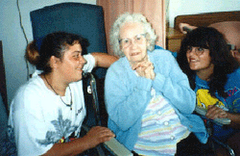Mar 17, 2007
C.S. Lewis on the Web
The most interesting and profitable moral and historical discussions on the web are found at John C. Wright's Live Journal. I keep thinking I'm reading and hearing another C.S. Lewis! However, I have scanned his Orphans of Chaos and cannot recommend it. It was written before his conversion.
God and God-Like
An old friend, Mrs. V and I had lunch together recently and we've decided to keep in contact more regularly. We discussed the 'every-man-is-God' heresy that seems to tempt so many Christians today. The error has many variations.
A good alternative to "every-man-is-God" is to unite our will completely with God's will. As Jesus recommended, strive to be perfect like His heavenly Father (Matt. 5:48). The Imitation of Christ is a traditional Catholic work advising a Christian how to pursue holiness and communion with God.
- A person believes he can make his own ethical and moral rules by which to live--according to his own viewpoint and needs
- A person does not commit grave (mortal) sins and thus does not need Christ's redemption
- The Divine nature of Jesus Christ is confused with God's power keeping human beings in existence
- The nature of Godhood (e.g., omniscient, timeless, unchanging) is distorted
- A person believing he is God has a difficult time practicing humility
- A person denies he is sinful and makes excuses for sins
A good alternative to "every-man-is-God" is to unite our will completely with God's will. As Jesus recommended, strive to be perfect like His heavenly Father (Matt. 5:48). The Imitation of Christ is a traditional Catholic work advising a Christian how to pursue holiness and communion with God.
Mar 11, 2007
Quote - by John C. Wright
Everything in paganism from which the civilized mind recoils, as slavery, infanticide, polygamy, sodomy, had been defeated by Christianity, and made a recurrence only when and where Christianity retreats. [From his conversion story. I was fascinated.]
The Traditional Latin Mass in Pittsburgh --Fr. Kenneth Myers
The March 2007 issue of Homiletic & Pastoral Review, the oldest Catholic priests' magazine in the U.S., has an article on the traditional Latin Mass by a diocesan priest who celebrates regularly both the Old Latin Mass and the New English Mass. Fr. Kenneth E. Myers describes why the beauty, sacredness and solemnity of the traditional Latin Mass helps people pray and worship God. Fr. Kenneth Baker, S.J. concurs in his magazine editorial, "Reflections on the traditional Latin Mass."
One of the frank quotes of Fr. Kenneth E. Myers who was ordained in 1980:
One of the frank quotes of Fr. Kenneth E. Myers who was ordained in 1980:
Some people reading this article may make the accusation that traditional-minded Catholics are attacking the new rite of Mass. I tried for the longest time never to say anything negative about the Mass of Pope Paul VI. In fact, I offer it almost every day because I cannot offer the traditional Mass. I never doubt its validity and I always offer it with as much devotion as I can muster. However, I am not blind. I can make comparisons between the new and the old, and I can see the theological and spiritual shortcomings of the new rite: its failure to express the fullness of Catholic Faith about the Eucharist and the priesthood, its inability to raise up heart and mind from the profane to the supernatural, its confusion on the role of the priest, and its unfaithful and banal translations of the original Latin text. How do we hold on to what we believe in without making these negative comparisons? It is a difficult task.Fr. Myers is described in the HPR article as a "parish priest permitted by my bishop to offer this rite of Mass and serve a community of over 800 people who are devoted to the Traditional Latin Mass. [He is] chaplain of the Pittsburgh Latin Mass Community, the largest diocesan Latin Mass community in the United States."
Pornography and the Archbishop
Archbishop Joseph F. Naumann of Kansas City, KS has initiated an important program aimed at fostering the virtue of chastity and building awareness of the evil effects of pornography, including suggesting ways Catholics can protect their families from its influence and counseling persons caught in this sin. [Although, the best help I personally can think of is to make a good confession that will supply God's grace to avoid the near occasions of sins.]
Every parish was required to show a movie of the Archbishop announcing As for Me and My House at all weekend Masses. As people left the churches they were handed material to take home, including a good checklist for a spiritually healthy family. The Archbishop's newspaper, The Leaven, also provided an important article on pornography. [I can vouch for the problem of pornography within the workplace--several years ago we had to discharge a good employee. He was warned, but continued his pornographic viewing anyway.]
What is missing from As for Me and My House? I don't see a recommendation that parents install and use filters on their internet and cable service. One internet filter that can be highly recommended is found here. Other filters are described and rated here.
Every parish was required to show a movie of the Archbishop announcing As for Me and My House at all weekend Masses. As people left the churches they were handed material to take home, including a good checklist for a spiritually healthy family. The Archbishop's newspaper, The Leaven, also provided an important article on pornography. [I can vouch for the problem of pornography within the workplace--several years ago we had to discharge a good employee. He was warned, but continued his pornographic viewing anyway.]
What is missing from As for Me and My House? I don't see a recommendation that parents install and use filters on their internet and cable service. One internet filter that can be highly recommended is found here. Other filters are described and rated here.
St. Peter's Cathedral, Kansas City, KS
I traveled to St. Peter's Cathedral where 13 people had arrived early on Saturday morning to say the rosary before the 8:30 a.m. Mass. The side chapel has no visible tabernacle, so I left through a side door to visit the Blessed Sacrament in the main part of this beautiful Cathedral structure which seems to have been preserved from most of the ravages of the past 40 years.
The front of the chapel has a panel of Our Lady of Guadalupe and a statue of St. Joseph holding the baby Jesus. In the center alcove is a crucifix that is surrounded by green plants (perhaps artificial).
About 60 persons were present when Mass began, including one large extended family with small children that swelled the assembly in the small chapel with younger people, including two or three men in their 20s. Most people were older and white, and three or four Latinos were seen, but no blacks. The priest was assisted by an altar girl and an altar boy. A white-haired older woman in jeans was the reader.
As with other churches visited, the clothing worn was casual, informal, mostly jeans for people less than about 45 (including very torn jeans on one woman), and even one low-cut cleavage blouse.
The priest seemed deliberately slow and reverent in the prayers of the Mass, and appeared to be completely faithful to the rubrics required by the Church. He gave a short homily on how God has selected us, more than we have chosen Him.
The Mass was over within a short time, and I felt sad because people left so quickly after receiving Holy Communion--perhaps without adequate understanding of the Sacrament that remains with us for an estimated 10 to 15 minutes after reception (as long as the forms of bread and wine are distinguishable).
The front of the chapel has a panel of Our Lady of Guadalupe and a statue of St. Joseph holding the baby Jesus. In the center alcove is a crucifix that is surrounded by green plants (perhaps artificial).
About 60 persons were present when Mass began, including one large extended family with small children that swelled the assembly in the small chapel with younger people, including two or three men in their 20s. Most people were older and white, and three or four Latinos were seen, but no blacks. The priest was assisted by an altar girl and an altar boy. A white-haired older woman in jeans was the reader.
As with other churches visited, the clothing worn was casual, informal, mostly jeans for people less than about 45 (including very torn jeans on one woman), and even one low-cut cleavage blouse.
The priest seemed deliberately slow and reverent in the prayers of the Mass, and appeared to be completely faithful to the rubrics required by the Church. He gave a short homily on how God has selected us, more than we have chosen Him.
The Mass was over within a short time, and I felt sad because people left so quickly after receiving Holy Communion--perhaps without adequate understanding of the Sacrament that remains with us for an estimated 10 to 15 minutes after reception (as long as the forms of bread and wine are distinguishable).
Subscribe to:
Comments (Atom)








